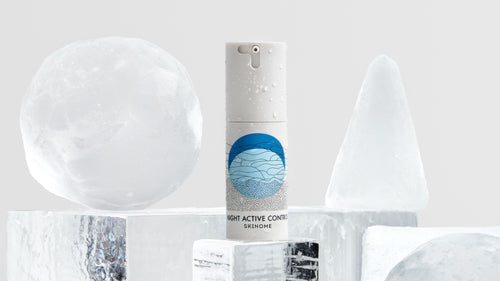PRENUMERERA & SPARA 20%
FRI FRAKT
Kommer du ihåg ditt lösenord?
Subscribe to receive a guaranteed shipment of formula every month.
Enjoy a {{ discount_amount }} discount on product throughout your subscription.
Change or cancel your subscription at any time!


Även om vi i den här artikeln kommer att fokusera på prebiotika vill vi börja med att förklara vad den allmänna termen "biotika" står för. Definitionen av ‘biotika’ omfattar prebiotika, probiotika och postbiotika, som alla används för att berika och balansera vårt mikrobiom. Det är viktigt att komma ihåg att vår hudhälsa inte bara påverkas av vad vi applicerar på vår hud utan också vilken typ av mat vi äter, vilket kommer att diskuteras närmare i den här artikeln.
Prebiotika är en grupp näringsämnen som fungerar som näring för våra nyttiga bakterier i tarmen och huden. De vanligaste prebiotika är kolhydrater, som kan ha olika former, t.ex. sockerarter, fibrer och stärkelse.
Tidigare studier har visat att prebiotika har flera fördelar för vår gastrointestinala hälsa och har rapporterats ha en positiv inverkan på andra organ, t.ex. immunförsvaret och det centrala nervsystemet.
Prebiotikabehandling har också visat sig ha stor potential när det gäller behandling av olika hudtillstånd, t.ex. atopiskt eksem, eksem, dermatit och akne. För att illustrera detta har forskarna Foolad och Armstrong gjort en studie där barn fick en modersmjölksersättning som bestod av 90 % GOS (galakto-oligosackarider) och 10 % långkedjiga FOS (frukto-oligosackarider). Forskningsresultaten visade på minskad förekomst av atopiskt eksem hos barn från riskgruppen. I en liknande studie som forskaren Bunselmeyer genomförde 2006 upptäckte man ett samband mellan prebiotika och ökningen av bifidobakterier som påverkar allvarlighetsgraden av atopiskt eksem.
Det finns också vetenskapliga bevis för att prebiotika har en positiv inverkan på vår hudhälsa, till exempel genom att hålla fukten. Detta återspeglades i ett experiment som utvecklades av Kano med team, där 40 frivilliga kvinnor fick antingen en flaska probiotisk och prebiotisk mjölk eller icke-fermenterad mjölk som inte innehöll vare sig probiotika eller prebiotika. Studien visade att i jämförelse med den aktiva gruppen var återfuktningen i kontrollgruppens deltagares yttersta hudlager (stratum corneum) betydligt lägre (p = 0,031). Vidare indikerar forskarna Ghazzewi och Tester att prebiotika har en positiv inverkan på huden, eftersom de balanserar immunförsvaret och har visat lovande resultat vid behandling av atopiska sjukdomar.




Hur kan vi då få i oss prebiotika? Den goda nyheten är att denna specifika biotikagrupp kan hittas både i livsmedel och i hudvårdsprodukter.
Låt oss börja med maten! Prebiotika finns i olika livsmedel, såsom lök, vitlök, jordärtskockor, sparris, sockerbetor, omogna bananer, havregryn, kall potatis, majs, vete, honung, korn, tomater, råg, sojabönor, sjögräs och mikroalger.
De vanligaste prebiotika i hudvårdsprodukter är inulin, glukomannan, oligosackarider, xylitol, rhamnos. Dessa ingredienser hjälper huden att bibehålla balans och optimal mikrobiomhälsa.


Prebiotika i Skinomes produkter
Det prebiotiska elementet som finns i Skinomes produkter är Alpha Glucan Oligosaccharide som stimulerar tillväxten av nyttiga bakterier på huden och förhindrar oönskade mikroorganismer. Dessutom stimulerar det hudens försvar och återfuktar huden. Denna ingrediens hittar du i våra produkter:
Vår Night Active Retinol innehåller bl.a. prebiotika och hudeget retinol då vårt fokus är att efterlikna hudens naturliga komposition i så stor utsträckning som möjligt. Night Active Retinol passar normal till torr hud bäst.
Vår Night Active Control innehåller också prebiotika och hudeget retinol då vårt fokus är att efterlikna hudens naturliga komposition i så stor utsträckning som möjligt. Night Active Control passar normal hud men även oljig och aknebenägen hud.
Al-Ghazzewi, F. H., & Tester, R. F. (2014). Impact of prebiotics and probiotics on skin health. Beneficial microbes, 5(2), 99–107. https://doi.org/10.3920/BM2013.0040.
Bockmühl D, Jasoy C, Nieveler S, Scholtyssek R, Wadle A, Waldmann-Laue M. Prebiotic cosmetics: an alternative to antibacterial products. IFSSC Mag 2006;9:1–5.
Bunselmeyer B. (2006). Probiotika und Präbiotika zur Prävention und Therapie des atopischen Ekzems [Probiotics and prebiotics for the prevention and treatment of atopic eczema]. Der Hautarzt; Zeitschrift fur Dermatologie, Venerologie, und verwandte Gebiete, 57(9), 785–791. https://doi.org/10.1007/s00105-005-1034-2.
Dall'Oglio, F., Milani, M., & Micali, G. (2018). Effects of oral supplementation with FOS and GOS prebiotics in women with adult acne: the "S.O. Sweet" study: a proof-of-concept pilot trial. Clinical, cosmetic and investigational dermatology, 11, 445–449. https://doi.org/10.2147/CCID.S179627.
Davani-Davari D, Negahdaripour M, Karimzadeh I, et al. Prebiotics: Definition, Types, Sources, Mechanisms, and Clinical Applications. Foods. 2019;8(3):92. Published 2019 Mar 9. doi:10.3390/foods8030092.
Foolad N, Armstrong AW. Prebiotics and probiotics: the prevention and reduction in severity of atopic dermatitis in children. Benefic Microbes. 2014;5 (2):151–60. Epub 2014/01/28.
Gillbro Johanna. The Scandinavian Skincare Bible. 2020. Scribe Publications. ISBN: 9781912854943.
Holland KT, Bojar RA. Cosmetics. What is their influence on the skin microflora? Am J Clin Dermatol 2002;3:445–9.
Kano M, Masauoka N, Kaga C, Sugimoto S, Iizuka R, Manabe K, Sone T, Oeda K, Nonaka C, Miazaki K, Ishikawa F (2013) Consecutive intake of fermented milk containing Bifidobacterium breve strain yakult and galacto-oligosaccharides benefits skin condition in healthy adult women. Biosci Microbiota Food Health 32:33–39.
Maguire, M., & Maguire, G. (2017). The role of microbiota, and probiotics and prebiotics in skin health. Archives of dermatological research, 309(6), 411–421. https://doi.org/10.1007/s00403-017-1750-3.
Ouwehand, Arthur & Tiihonen, Kirsti & Lahtinen, Sampo. (2010). The Potential of Probiotics and Prebiotics for Skin Health. 10.1007/978-3-540-89656-2_77. Pages: 1300.